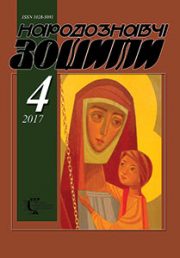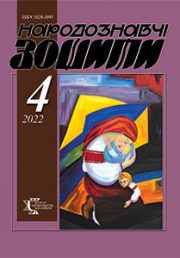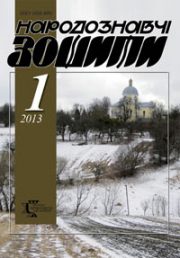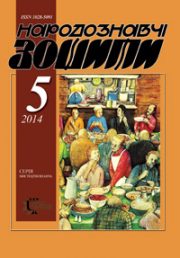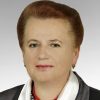The Ethnology Notebooks. 2025. № 4 (184), 785—799
UДК: 39+069.01/04+069.02:929+908 (477.83)(045)”18/19″
DOI https://doi.org/10.15407/nz2025.04.785
ETHNOGRAPHIC COLLECTION OF THE DZIEDUSZYCKI MUSEUM: HISTORY OF FORMATION
HORBAN Iryna
- ORCID ID: https://orcid.org/0000-0002-2626-9521
- Candidate of Philological Sciences (Ph.D.),
- Associate Professor, Senior Researcher
- at the Museum of Ethnography and Art Crafts of the Ethnology Institute of the National Academy of Sciences of Ukraine,
- 15, Svobody Avenue, 79000, Lviv, Ukraine,
- Contacts: e-mail: ir.horban@gmail.com
Abstract. The article is devoted to one of the little-studied ethnographic collections that operated in Lviv at the end of the 19th — the first third of the 20th century — the ethnographic collection of the Didushytsky Museum. This collection was created thanks to the efforts and enthusiasm of Count Volodymyr Didushytsky with the active cooperation of the well-known Ukrainian ethnographer Volodymyr Shukhevych.
The period of the greatest flowering of the collection falls on the beginning of the 20th century, when the reorganization of the museum exposition took place. After the occupation of Lviv by Soviet troops at the beginning of World War II, the ethnographic collection was removed from the Didushytsky Museum, which was liquidated by the new authorities. As a result of several relocations and changes in the institutional subordination of institutions, it ended up in the Museum of Ethnography and Crafts (now the Museum of Ethnography and Crafts of the Institute of Ethnology of the NAS of Ukraine), where it is currently stored in various fund groups. Modern researchers mention it mainly in the context of research into the history of Lviv museum.
The purpose of the article is to collect and systematize information from all available sources, which will allow forming a holistic idea of the ethnographic collection of the Didushytsky Museum. The prerequisites for the creation of this collection and the stages of forming an ethnographic exposition are highlighted for the first time. The contribution of the famous Ukrainian ethnographer Volodymyr Shukhevych to the development and replenishment of the ethnographic collection of the Didushytsky Museum, in particular, the formation of the Hutsul collection, is indicated.
The importance of establishing the provenance of monuments from the ethnographic collection of the Didushytsky Museum in the modern collections of the Museum of Ethnography and Crafts of the Institute of Ethnology of the National Academy of Sciences of Ukraine is emphasized.
The relevance of the research is due to the need to study the ethnographic collection of the Didushytsky Museum as one of the centers of preservation of the Ukrainian historical and cultural heritage and the lack of publications devoted to this issue. The source base of the research consists of individual works (catalogs, guidebooks) and articles published in periodicals of the late 19th century, which have become a bibliographical rarity and are difficult to access for modern researchers, as well as a number of archival documents and photographic materials, which are an additional source for recreating the history of the ethnographic collection of the Didushytsky Museum and are being introduced into scientific circulation for the first time.
Keywords: ethnographic collection, Dzieduszycki Museum, Wіodzimierz Dzieduszycki, Volodymyr Shukhevych, Lviv museums, museology, Lviv, Galicia.
Received 27.07.2025
REFERENCES
- Skrypnyk, G.A. (1989). (Ed.). Ethnographic Museums of Ukraine: Formation and Development. Academy of Sciences of the Ukrainian SSR, Institute of Art History, Folklore and Ethnography named after M.T. Rylsky. Kyiv: Naukova dumka [in Ukrainian].
- Matwijow, M. (2006). Lviv museums yesterday and today. Independence and Memory, 24, 175—196 [in Polish].
- Kushnir, V. (2021). Museum of the Shevchenko Scientific Society (1892—1940). Lviv: Institute of Ethnology of the NAS of Ukraine [in Ukrainian].
- Skrzydlewska, B. (2022). Religious museums of Lviv at the turn of the 19th and 20th centuries against the background of city and private museums. Facta Simonidis, 2 (15), 51—65 [in Polish].
- Chornovol, I.P., & Smolii, V.A. (Ed.). (2004). Didushycky Volodymyr. Encyclopedia of Ukrainian History (Vol. 2: G—D). NAS of Ukraine. Institute of Ukrainian History. Kyiv: Naukova dumka. Retrieved from: http://www.history.org.ua/?termin=Didushycky_Volodymyr (access date: 26.06.2025) [in Ukrainian].
- Chlapowski, F. (1900). Wlodzimierz Dzieduszycki: a posthumous memoir (read at the meeting of the Faculty of Natural Sciences on November 23, 1899): Reprint from the Yearbook of the Poznan Society of Friends of Science (Vol. XXVI). Poznan [in Polish].
- Grzegorz, F. (1998). Count Wlodzimierz Dzieduszycki. Academic Forum, 3. Retrieved from: https://forumakademickie.pl/media/archiwum/98/3/artykuly/21-mecenasi.htm (date of publication: July 19, 2025) [in Polish].
- Brzek, G. (1994). The Dzieduszycki Museum in Lviv and its Creator. Lublin: Wydawnictwo Lubelskie Nowe [in Polish].
- (1907). Guide to the Dzieduszycki Museum in Lviv, ed. 2. Lviv: Publishing Committee. Dzieduszycki Museum [in Polish].
- Dzieduszycki, W. (Jun.). (2022). Note to the papers concerning the collection of „conchilia” of Paulina Józefowa Dzieduszycka, nee Dzialynska, as the first fruits of the Dzieduszycki Museum in Lviv (source: Archives of the Museum and Institute of Zoology of the Polish Academy of Sciences). Around the Dzieduszyckis natural passions: Papers presented at the conference inaugurating the celebration of the 200th anniversary of the birth of Wlodzimierz Dzieduszycki (1825—1899) (Zarzecze, September 10, 2021) (Pp. 165—166). Warsaw [in Polish].
- Dyadyuk, M. (2012). The Didushytsky Library: history, ways of forming the funds. Notes of the Lviv National Scientific Library of Ukraine named after V. Stefanyk, 4, 431—454. Retrieved from: http://nbuv.gov.ua/UJRN/lnnbyivs_2012_4_28 (access date: 31.08.2023) [in Ukrainian].
- Sidorowicz-Mulak, D. (2022). The Poturzycka Library in Lviv — history and collections. Around the Dzieduszycki family’s collecting passions. Papers presented at a conference organized as part of the celebration of the 200th anniversary of the birth of Wlodzimierz Dzieduszycki (1825—1899) (Zarzecze, September 30, 2022) (Pp. 36—65). Warsaw [in Polish].
- Franczyk-Cegla, A. (2022). Selected rarities among the Polonia of the Poturzycki Library. On the collecting passions of the Dzieduszycki family. Papers presented at a conference organized as part of the celebration of the 200th anniversary of the birth of Wlodzimierz Dzieduszycki (1825—1899) (Zarzecze, September 30, 2022) (Pp. 66—97). Warsaw [in Polish].
- Petryszak, B. (2022). Manuscripts of the Poturzycki Library in the Central State Historical Archives of Ukraine in Lviv. On the collecting passions of the Dzieduszycki family. Papers presented at the conference organized as part of the celebration of the 200th anniversary of the birth of Wlodzimierz Dzieduszycki (1825—1899) (Zarzecze, 30 September 2022) (Pp. 116–129). Warszawa [in Polish].
- Bokotey, A., Dzyubenko, N., & Susulowska, I. (2022). The natural history section of the Poturzycki Library in the collection of the State Museum of Natural History of the National Academy of Sciences of Ukraine in Lviv. On the collecting passions of the Dzieduszycki family. Papers presented at a conference organized as part of the celebration of the 200th anniversary of the birth of Włodzimierz Dzieduszycki (1825—1899) (Zarzecze, September 30, 2022) (Pp. 130—149). Warsaw [in Polish].
- (1880). The Dzieduszycki Museum in Lviv. Zoological, vertebrate department. II Birds. Lviv: I Zwiazkowa drukarnia [in Polish].
- Boyko, O., & Slobodian, V. Vul. Lysenko, 15 — building of the SBU administration (former palace of the Didushytskys). Retrieved from: https://lia.lvivcenter.org/uk/objects/lysenka-15/ (access date: 16.06.2025) [in Ukrainian].
- Smirnov, Y., Kharchuk, Kh., & Kozytsky, A. (Ed.). (2008). Didushytsky Palace. Encyclopedia of Lviv (Vol. 2, pp. 87—89). Lviv: Litopys [in Ukrainian].
- Boyko, O., & Slobodian, V. Vul. Teatralna, 18 — building of the natural history museum (former palace). Retrieved from: https://lia.lvivcenter.org/uk/objects/teatralna-18/ (access date: 27.05.2025) [in Ukrainian].
- Zawadzki, Wl. (1875). Count Wlodzimierz Dzieduszycki. Klosy, 511 (Vol. XX, pp. 227, 230) [in Polish].
- (1880). Grand Dzieduszycki Museum in Lviv: 1. Department — Vertebrate Zoology, 2 — Birds. Lviv [in German].
- Shukhevych, V. (1892). Museum named after Dziedushitsky. Dilo. Ch. 74, 31 March (12 April). P. 1; Ch. 75, 1 (13) April. P. 1; Ch. 76, 2 (14) April. P. 1—2 [in Ukrainian].
- Taborski, A. (2013). The Origin and History of the Dzieduszycki Natural History Museum in Lviv. Opuscula Musealia (Vol. 21, pp. 189—207) [in Polish].
- Manikowska, E. (2024). Włodzimierz Dzieduszycki and the Importance of House Industry in the Last Quarter of the 19th Century. On the Ethnographic Passions of the Dzieduszycki Family. Papers Presented at a Conference Organized as Part of the Celebration of the 200th Anniversary of the Birth of Włodzimierz Dzieduszycki (1825—1899) (Zarzecze, September 22, 2023) (Pp. 24—45). Warsaw [in Polish].
- Dolinska, M. (2024). Ethnographic Collecting of Włodziemierz Dzieduszycki in the Context of his Participation in Industrial Exhibitions and Relations with the Museum of Technology and Industry in Krakow. On the ethnographic passions of the Dzieduszycki family. Papers presented at a conference organized as part of the celebration of the 200th anniversary of the birth of Włodzimierz Dzieduszycki (1825—1899) (Zarzecze, September 22, 2023) (Pp. 46—75). Warsaw [in Polish].
- (1895). Guide to the Dzieduszycki Museum in Lviv. Lviv: Published by the Dzieduszycki Museum [in Polish].
- Dzieduszycki, W. (1896). Guide through the Count Dzieduszyck Museum in Lviv. Lviv [in German].
- Shukhevych, V. (1899, 1901, 1902, 1904, 1908). Hutsulshchyna (Parts 1–5). Lviv: Shevchenko Scientific Society (Parts 1–4, published as Materials for Ukrainian-Ruthenian Ethnology, Vols. 2, 4, 5, 7, edited by Khv. Vovk); Lviv: General Printing House (Part 5) [in Ukrainian].
- Central State Historical Archive of Ukraine (Lviv). F. 64. Op. 1. Case 275: Letters to Count Didushytsky from Shnyur, Shernberg Khryzant, Sharfer Edward, Shukhevych Volodymyr [in Ukrainian].
- Szuchiewicz, W. (1899). The Dzieduszycki Museum in Lviv. Ethnographic. Hutsul region. Lviv: Published by the Dzieduszycki Museum [in Polish].
- Szuchiewicz, W. Hutsul region (Vol. 1—4). Lviv: Published by the Dzieduszycki Museum in Lviv, 1902—1908 [in Polish].
- Scientific Library of the State Natural History Museum of the National Academy of Sciences of Ukraine. Manuscripts Department. F. 1. Op. 1. Case 23: Report on the work of the Museum 1899—1913 [in Polish].
- Benkowski, A. (1900). The Dzieduszycki Museum in Lviv and its founder. Tygodnik Ilustrowany, 12, 230–234 [in Polish].
